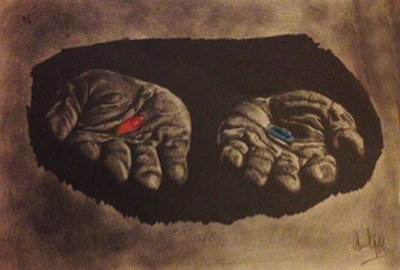The Placebo Effect
This creative piece was inspired by a study in the paper Deconstructing the Placebo Effect [1]. A group of students took part in a study of two drugs, supposedly one a tranquilizer and the other a relaxant. However, both of the pills were completely inert. Each student was given either one or two red or blue pills. The responses to the drugs were fascinating – the red pill acted as a stimulant and the blue pill acted as a depressant. The students also experienced an enhanced effect when two pills were taken. Since the pills were all placebos, why did the students perceive the red drug to be the stimulant and the blue to be a depressant? The significance of colour was explored in the paper – Red was seen as danger – up and hot whereas blue meant down cool or quiet. I drew the hands with graphite in black and white to fore-ground the colours. The artwork is intended to highlight both how colour can influence how we perceive things and how it can make us feel. In this example it was not the person giving the students the drugs who informed them about the anticipated response – it was the students themselves who made the decision subconsciously based merely on what they could see.
I greatly enjoy drawing. It gives me an opportunity to chill out, listen to music and forget about other things that are going on. You could say it may be a retreat from reality. This coursework gave me an opportunity to do something that I love but put a meaningful twist to it. For me, art is all the more satisfying if there is a message or theme that is locked up inside it. I like the way that any art form can be perceived in many different ways depending on who is looking at it and how creative pieces reflect the differing personalities of the artists.
Daniel E. Moerman. Deconstructing the Placebo Effect and Finding the Meaning Response. Perspective. 2002;136:471-476
Curator’s Comment
This is an extract from a comprehensive exploration of this topic. In the full text, Edward highlights the implications of using placebos in a variety of medical contexts including patients in vulnerable situations: There are many ethical and moral issues about the deceit which may be involved in giving someone in such a fragile state an inert treatment. This could be seen as abuse of their hope.

This art piece immediately caught my attention. The artist really shows an understanding of the idea of placebo and how easily our minds can be manipulated by simple things such as colour. By comparing it to the popular scenario in pop culture, it grounds a very complex medical idea in a relatable and comprehensible representation. The placebo effect is fascinating from a medical perspective, but it is important not to forget that we are dealing with patients who will probably not be quite as interested in this when their own health is the concern. That is why I believe this piece captures the situation so well – it is a dilemma, both ethically and morally.